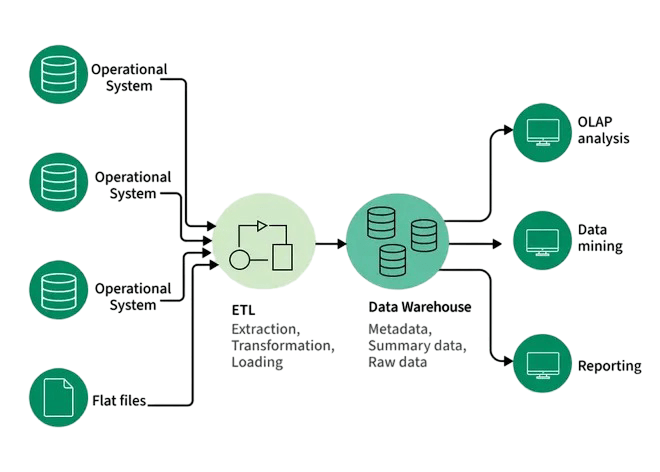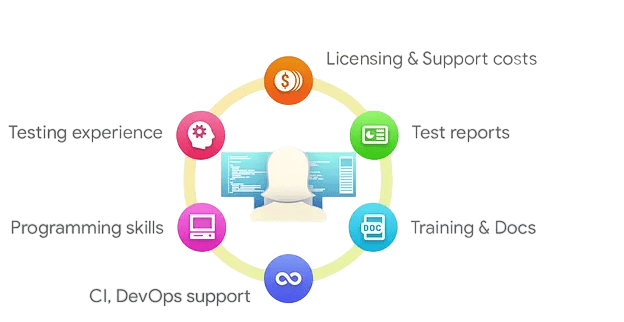
- Introduction to Data Warehousing
- Importance of Tools in DW
- Top ETL Tools (Informatica, Talend)
- Cloud DW Tools (Snowflake, BigQuery)
- Reporting & BI Tools (Power BI, Tableau)
- Data Modeling Tools
- Data Integration Tools
- Criteria for Tool Selection
- Trends in Data Warehousing Tools
- Summary
Introduction to Data Warehousing
Data warehousing (DW) refers to the process of collecting, storing, and managing large volumes of data from various sources to enable analysis and reporting. Database Training introduces foundational concepts in data architecture. A data warehouse is a centralized repository designed for query and analysis rather than transaction processing. It stores historical and current data to support business intelligence (BI) and decision-making.

The concept emerged in the 1980s and 1990s as businesses recognized the need to consolidate disparate data sources into a unified system to generate insights. Unlike operational databases optimized for day-to-day transactions, data warehouses are structured to facilitate complex queries and analytics, often involving large datasets. A modern data warehouse integrates data from multiple systems such as ERP, CRM, web logs, and social media feeds. This integration enables comprehensive, high-quality reporting and analytics that guide strategic business decisions.
Do You Want to Learn More About Database? Get Info From Our Database Online Training Today!
Importance of Tools in Data Warehousing
Data warehousing projects are complex and require specialized tools to manage the various stages: In data management, modern ETL tools are essential for turning raw information into useful insights. These solutions automate the complex process of extracting data from various source systems. MySQL Databases are widely used for data transformation tasks. They transform the data carefully to ensure quality and consistency, then load it into data warehouses. By using data modeling techniques like star, snowflake, and galaxy schemas, these tools help organizations design strong data structures that clarify relationships and improve how information is organized. Additionally, they integrate data from different sources and formats, breaking down barriers and creating a unified view of organizational information. Alongside these features, reporting and business intelligence tools create dynamic dashboards, engaging visualizations, and detailed reports that allow end-users to explore and analyze data in depth. With strong administration and monitoring features, these tools maintain system health, optimize performance, and ensure strict data security. They have become vital in today’s data-driven business environment. The right tools improve productivity, reduce errors, and ensure that the data warehouse delivers accurate and timely insights.
Top ETL Tools (Informatica, Talend)
ETL tools are the backbone of data warehousing, responsible for moving data from source systems to the warehouse.
Informatica PowerCenter:
- One of the most widely used ETL platforms.
- Supports complex data integration scenarios.
- Offers a graphical interface for designing ETL workflows.
- Scalable architecture suitable for large enterprises.
- Advanced features: include metadata management, data cleansing, and real-time integration.
- Extensive connectivity to various data sources and targets.
Talend Open Studio:
- Open-source: ETL tool with a growing enterprise version.
- Provides a visual drag-and-drop interface.
- Supports: big data integration, cloud services, and real-time processing.
- Integrates well with Hadoop, Spark, and other modern data platforms.
- Active community and marketplace for components.
Both tools offer robust features but cater to different budgets and project scales. Informatica tends to be preferred by large corporations due to its maturity and support, while Talend is favored by organizations seeking flexible, cost-effective solutions.
Would You Like to Know More About Database? Sign Up For Our Database Online Training Now!
Cloud Data Warehousing Tools (Snowflake, BigQuery)
Cloud adoption has revolutionized data warehousing by offering scalable, flexible, and cost-effective solutions without the overhead of managing physical infrastructure. Snowflake and Google BigQuery are advanced cloud-based data warehouse solutions that change the way companies manage data. Snowflake stands out because it has a unique design that separates computing from storage. Understanding What are DDL and DML Commands is fundamental for grasping how databases interact with cloud infrastructure. This allows for independent scaling across various cloud platforms, such as AWS, Azure, and Google Cloud. Its notable features include zero-copy cloning, time travel, and support for semi-structured data formats. Snowflake also offers a flexible pricing model, so organizations only pay for what they use. On the other hand, Google BigQuery provides a fully managed, serverless experience with automatic scaling. It uses a powerful columnar storage format and the Dremel query execution engine. Both platforms support standard SQL for querying and easily work with business intelligence tools. They give organizations strong, scalable analytics solutions capable of handling complex workloads with great performance and efficiency. Both Snowflake and BigQuery emphasize ease of use, scalability, and advanced analytics, positioning them as leaders in the cloud data warehousing market.
Reporting & BI Tools (Power BI, Tableau)
Once data is loaded and processed, business users need tools to visualize and interpret data insights. Microsoft Power BI and Tableau are two leading business intelligence platforms that provide strong data visualization and analytics features. Power BI is a user-friendly option that works well with Microsoft’s ecosystem. Database Training provides practical skills for working with modern reporting tools. It allows users to create reports easily using drag-and-drop features and includes natural language query options. Its real-time data streaming, mobile apps, and sharing capabilities make it versatile for organizations looking for flexible reporting tools. Tableau adds to these strengths by offering interactive and visually appealing data visualizations. It has powerful calculated fields and dashboarding features that enable detailed drill-downs and filtering. Both platforms have strong community support and receive frequent updates, making them effective tools for modern, data-driven businesses that want to turn complex information into actionable insights through effective analytics and easy-to-use design. Both tools empower users to convert raw data into actionable insights, but Power BI is often preferred in Microsoft-centric environments, while Tableau is favored for its visualization capabilities.
To Earn Your Database Certification, Gain Insights From Leading Blockchain Experts And Advance Your Career With ACTE’s Database Online Training Today!
Data Modeling Tools
Data modeling defines the structure of the data warehouse, critical for performance and usability.
- ER/Studio: Advanced modeling tool supporting logical and physical models.
- IBM InfoSphere Data Architect: Integrates with IBM data tools for comprehensive modeling.
- PowerDesigner: Offers enterprise architecture and data modeling, including impact analysis.
- Oracle SQL Developer Data Modeler: Free tool supporting logical, relational, and physical models.
- DbSchema: Visual interface supporting schema design, documentation, and query building.
Data modeling tools enable collaboration between business analysts and database architects, ensuring that the warehouse schema aligns with business requirements.
Data Integration Tools
Guide to Choosing an Enterprise Data Strategy highlights modern approaches to integration. Beyond ETL, data integration tools help unify data from various sources in real-time or batch modes.
- Microsoft SQL Server Integration Services (SSIS): Comprehensive integration for Microsoft environments.
- IBM InfoSphere DataStage: High-performance parallel processing for large volumes.
- Apache NiFi: Open-source tool for data flow automation with real-time capabilities.
- MuleSoft Anypoint Platform: Integration platform for connecting SaaS and enterprise apps.
- SnapLogic: Cloud-based platform supporting AI-driven integration.
These tools often include connectors, transformation logic, and monitoring to streamline data flows.
Preparing for a Database Job? Have a Look at Our Blog on Database Interview Questions and Answers To Ace Your Interview!
Criteria for Tool Selection
Choosing the right data warehousing tool depends on several key considerations:
- Data Volume & Velocity: High-volume real-time data may favor cloud or streaming tools.
- Integration Requirements: Number and types of data sources.
- Budget: Open source vs paid, total cost of ownership.
- Skillset: Team expertise with particular tools or platforms.
- Scalability: MongoDB vs SQL is a critical comparison when considering scalability. Ability to grow with data and user demands.
- Security & Compliance: Encryption, access control, audit trails.
- Performance Needs: Query speed, concurrency support.
- Vendor Support: SLA, community strength.
- Cloud vs On-premises: Deployment preferences.
A thorough evaluation using proof-of-concept projects often helps make the best choice.

Trends in Data Warehousing Tools
Several trends are shaping the future of data warehousing:
- Cloud Migration: Shift from on-premises to cloud-native warehouses like Snowflake and BigQuery.
- Automation & AI: Using machine learning to optimize ETL pipelines, query tuning, and anomaly detection.
- Data Lakehouse: Convergence of data lakes and warehouses for flexible storage and analytics (e.g., Databricks).
- Real-Time Analytics: Growing demand for streaming data integration and instant insights.
- Self-Service BI: Empowering business users with intuitive tools and natural language queries.
- Multi-Cloud & Hybrid Architectures: Avoiding vendor lock-in by supporting multiple cloud providers.
- Serverless Architectures: Reducing infrastructure management overhead.
Staying current with these trends ensures data warehousing remains aligned with business goals.
Summary
Data warehousing tools form the backbone of modern data-driven enterprises. From ETL and data integration to cloud data warehouses and BI platforms, these tools help collect, store, and analyze data effectively. Database Training supports mastery over key technologies in the data lifecycle. Leading ETL tools like Informatica and Talend streamline data movement, while cloud solutions like Snowflake and BigQuery offer scalable, flexible analytics. BI tools such as Power BI and Tableau convert data into actionable insights. Choosing the right combination depends on specific project needs, budgets, and existing infrastructure. With rapid innovations like AI automation and cloud-native architectures, the future of data warehousing tools promises greater agility and intelligence. Organizations leveraging the best tools can unlock the full potential of their data, enabling smarter decisions and competitive advantage.


